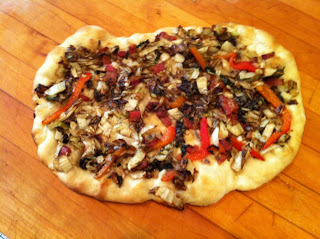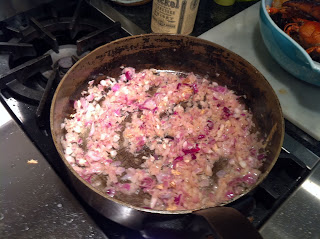And the method, in order to push our technological limits, sous-vide, based on some suggestions from Thomas Keller.
First, the breast was separated from the body of the squab.
The remainder of the squab (back, wings, etc.) went into the stockpot for stock and then sauce.
First the pieces were browned, then vegetables added, and they all simmered with water.
Meanwhile, the legs were placed in a sealable bag with some olive oil, and then sealed in the vacuum sealer.
Then they were placed in the pot of simmering water, with an ideal constant temperature of 69 degrees Celsius, and there they floated for two hours.
The ingenious temperature monitoring system uses an instant-read thermometer stuck through a plastic cork, floated on a Gladware plastic top.
Meanwhile, we prepared the acorn squash velouté, recipe courtesy of Hannah and Joshua, acorn squash courtesy of the Moore Family Farms, moldering in the wine cellar. Time to use it up. There must be a better way to peel acorn squash, and in any event, all the typos here are due to my slicing off a bit of my middle finger trying to peel them.
Once peeled, they are cubed, and added to some sauteed onion along with minced ginger. Saute and then simmer them in chicken stock for about 30 minutes.
and then blend with the immersion blender from last Christmas.
Add some tomato paste, salt, and cayenne, and work on the rest of the dinner.
For the squab breast, we decided to flavor it (in the absence of truffles, foie gras, and other requirements of the Keller recipe) with olive oil infused with star anise, coriander pods, and peppercorns. The reserved olive oil was added to the breast piece in its packet, and then vacuum sealed.
(This is an action shot. Imagine you can hear the machine sucking all the air out of the bag.)
Meanwhile, the legs, having been in their 68-69 degree C. bath for two hours, are removed and placed in ice water.
The breast goes in for 40 minutes (Keller said 30, we left it a little longer, maybe 5 minutes too long?) Remove from the water bath and go on to the next steps.
At the end, the legs and the breast will be briefly sauteed in the flavored olive oil, and topped with sauce.
For the sauce, we cooked up the squab livers, and sieved them.
We also sautéed some chanterelles that we had bought at the Lincoln Park Whole Foods on Wednesday morning.
For the rest of the vegetables and side dishes, we made roasted sweet potatoes (Cary's Garden) with fried sage (a recipe from a 2008 Gourmet: cut the potatoes into 1/2 inch rounds, marinate in garlic-infused olive oil, roast in a single layer at 450 degrees F. for 20-30 minutes, and top with the sage - the last of the year from our herb garden); buttered Brussels sprouts (Blue Moon); and puree of parsnips (Whole Foods) (recipe from Simon Hopkinson: cook the parsnips in milk, pass through a food mill, and whisk in the milk, butter, and some mustard). Here is another action shot of the whisking:
Our Thanksgiving meal is just about ready. First, the soup, with its garnish of sauteed cumin seed and mustard seed. We served it with a South African chenin blanc.
The trio of vegetables:
We served this with a 2005 Steltzner (Stag's Leap, Napa) cabernet sauvignon. Not sure what is the big deal with these fancy and pricey Napa wines.
Instead of the usual Thanksgiving post-prandial walk, we opted instead for an anti-capitalist movie at the Art Theater, Margin Call, by a new director, J.C. Chandor, with Kevin Spacey, Jeremy Irons, and Demi Moore.
Then back home for dessert, persimmon pudding (recipe from Chez Panisse fruit; persimmons from Cary's Garden).
R. made this while I was away conventioneering in DC. Here is the pulp that goes into the pudding:
And the final presentation, in all its gooey glory, with Prairie Fruits goat milk gelato on the side.
A sweet and fitting end to a day spent partly outdoors, filling the bird feeders, and fertilizing the lawn for spring; and partly indoors in the kitchen with all the enticing smells. Here we are on the sunny day after Thankgiving. Let it snow, if it must!



























































